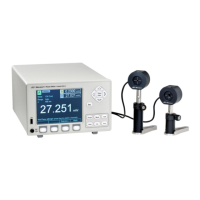7 Computer Interfacing
7.1 General Guidelines
The 1936/2936-R Series power meters have two computer interface ports:
USB and RS-232. These communication interfaces can be used to send
commands to the power meter from a host PC. The commands supported by
the power meter can be divided into the following two categories: commands
that cause the power meter to take a desired action, and commands (queries)
that return a stored value or state of the power meter.
Query commands are always terminated by a question mark (?). It is
recommended that when a query command is sent, the response to that
command from the power meter be read before issuing any other command.
Set commands, on the other hand, are used to configure/setup the power
meter for a desired mode of operation. These commands take at least one
parameter. The subsequent sections in this chapter detail the RS-232 and
USB communication protocols supported by the power meter.
7.2 Computer Interface Terminology
Listed below are the key abbreviations and concepts used in the command
reference section (Section 8) of this manual.
7.2.1 <…> Delimiting Punctuation
For the purposes of this manual, any string enclosed by <…> is considered to
be a command, a string or numerical argument. The punctuation <…> is
used to symbolize the typographic limits of the command, string or argument
in question.
7.2.2 <CR> Carriage Return
The ASCII encoded byte 13 in decimal. (0D hex)
7.2.3 <LF> Line Feed
The ASCII encoded byte 10 in decimal. (0A hex)
7.2.4 (;) Semicolons
Semicolons are used to separate commands within a single transmission
(concatenation).

